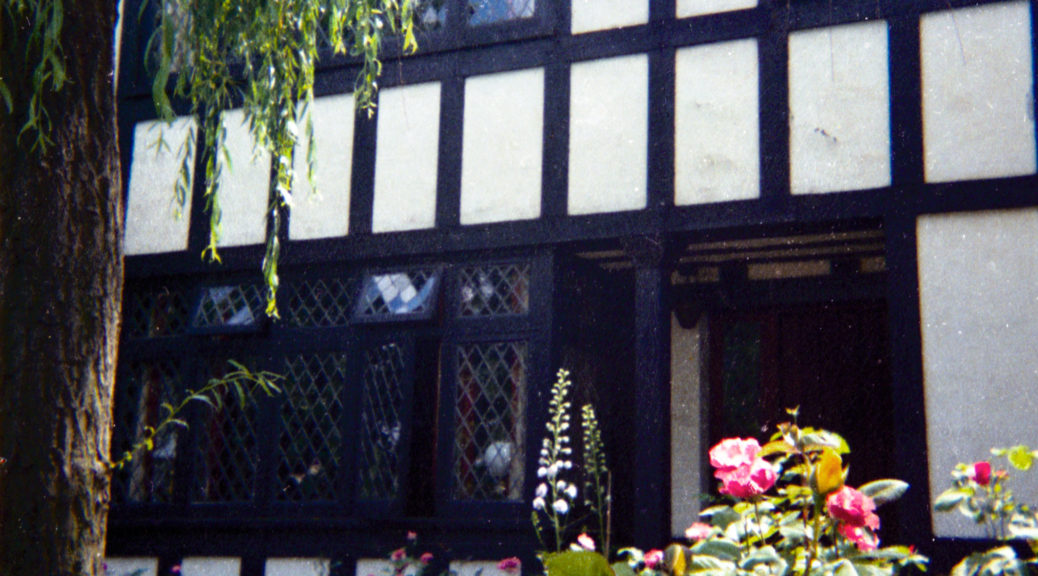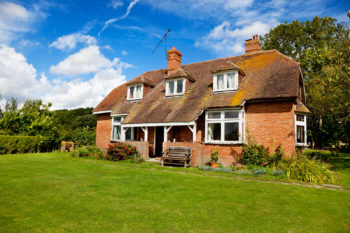
Many of the family stories have some relationship to the place in which they occurred – Knottingley, Yorkshire, or Detroit, Michigan – or to what a house or location meant to the people in the story. Good vs. bad neighborhoods, city vs. country, showy and fancy vs. warm and cozy. Sometimes it helps to know how far apart or near each other people’s homes were – Google maps tells me that it would have taken Len (my maternal grandfather) 15 minutes to walk over to Winnie’s (my maternal grandmother’s) house. This picture is of a house I have very fond memories of – Little Snagbrook, where Jill & Sven, Tim, Kate and Clive (aunt, uncle and cousins) lived in the 1960s. This picture was from 2010 when I was lucky enough to (a) be allowed to walk around by the current occupant and (b) have a beautiful sunny day in September to light up all the old brickwork.
In trying to piece stories together I realized a custom Google map might be helpful for readers to get a sense of place. There are many layers, roughly corresponding to family groups, so you can turn on or off whatever is relevant for you. The map is still being updated, so if you don’t see a location it may be I just haven’t got there yet, or it possibly is information I don’t have. Please email me about anywhere you’d like to see. I had done something similar for Detroit for a story about Jeffrey’s family
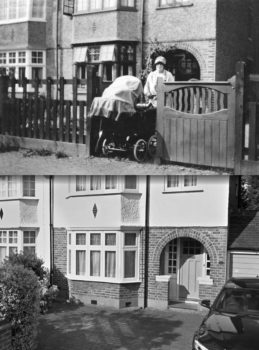
If you click on one of the pins on the map, a popup window has information and a link to open up regular Google maps so you can use street view and look around. Some areas (Detroit particularly) look nothing like they did when the story took place. Others – like this example of the house my mother was born in – look virtually unchanged from the outside. The top picture is of Gamma, my grandmother, taking her new baby for a stroll, and the bottom picture is from Google Street view of the house today. You have to hope that some interior upgrades (heating, kitchens, bathrooms and insulated windows) have moved the interior forward with the times! Those 20s cloche hats were not a good look for everyone…
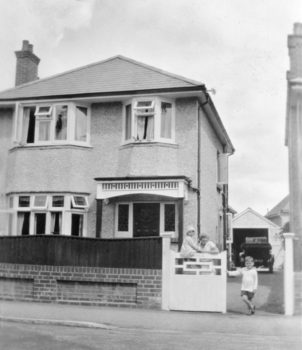
This is Gamps & Nanny’s house – called Totem – in Bournemouth, 1930 – 32. Lots of houses then had names, not numbers, so I can’t be sure, but I believe this is 27 Eldon Road. The chimney has been mostly removed and although there’s a new wall – other houses on the street still have the style of brick that this picture shows – there are enough similarities, I think that’s the one. When Dad labeled this picture in an album (a few years before he died) he was most impressed with the car parked behind him in the driveway! Always was car mad.
The area around the house is apparently much more built up than it was. An entry in Dad’s Progress Book (written by Nanny) said: “…a dear little modern house situated quite near the Talbot Pine Woods, the air there is lovely. We only go through Eldon Rd & are in a footpath leading to the woods. The children love it there. We get heather and pine-cones for the fire.”
Several stories my mother gathered about her parents, Len and Wynne Forster (neé Procktor) indicated that Wynne considered her family socially a cut above Len’s. When I looked at the streets they lived in before they married in Google street view, it struck me they were interchangeable Victorian terraced houses about 15 minutes walk apart (you can look at the Paget Rd and Lynmouth Rd via my map). It must have been the furnishings or tea service…
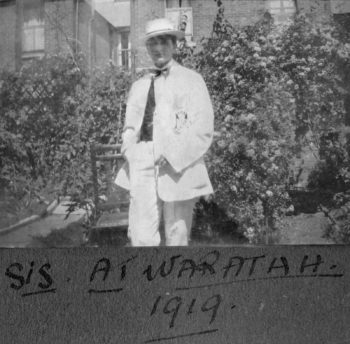
Naming houses was apparently a big thing – makes it hard to track locations down in a numbered-house era – but sometimes I got lucky and with the aid of Google street view and remaining live brain cells, I was able to make a positive ID.
One example involves a photo of Nanny’s sister captioned “Sis at Waratah 1919” – it sounded like a town name somewhere other than England. That made no sense as 1919 was the year she and Ernie were married in Portsmouth. I found the clothes a puzzle too, but as Nanny liked fancy dress parties, I figured Sis might too. I moved on to other things. I was locating the Williams home when Nanny & Sis’ Dad died (showed up in the probate record) in Google street view and noticed glass above one front door on a street of terraced houses said “Ivanhoe”. Some houses had obvious renovations, but many had kept the original glass above the door and all had different names. It then occurred to me that Waratah wasn’t a place in the empire or pretentious naming by the homeowners, but something the builder of the homes had done to give each identical house some differentiation.
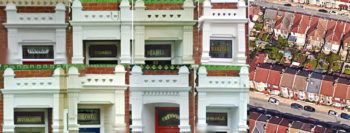
Sure enough, there was Waratah above one of the front doors! You can see some of the other examples as well as an aerial view of that part of the street showing the skinny back-to-back gardens. Many of the homes at left the facades alone, although one had flattened the front out and replaced brick with siding – really clashes with its neighbors (check out No. 80). I have also learned that Waratah is a type of protea and the floral emblem of New South Wales, Australia.
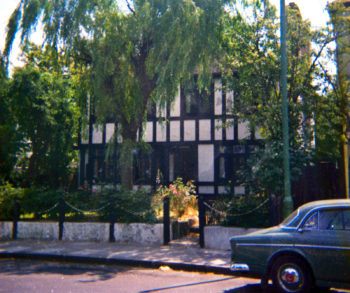
The picture headlining the blog is of 20 London Lane Bromley, where my four brothers and I spent most of our childhood years. The willow tree is gone (blown down in the great storm of October 1987); the beech hedge grew huge and the flaking paint on the low white wall is still flaking. Google street view shows the greenhouse is long gone (probably no great loss; England just isn’t great for grape-growing in spite of my father’s optimism that it might be).
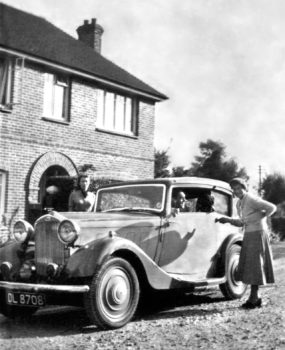
2a Lansdowne Road – our first home in Bromley after Dad and Peter Goss started running the New Theatre – has been demolished. The school I attended on Plaistow Lane has now been developed as “executive homes” with flats in the Grade II listed building that was the main office and Convent. It’s a pleasant surprise that many homes have survived. 2 Francis Way in Salisbury (where Gamps & Nanny retired and where I lived for my first 18 months is still there, although the cars are different and the road is paved! So is 1 Hailsham Road in Worthing where Wynne and Len Forster lived in retirement. I think Clarebridge in Taunton where Margo grew up is still there, but there is a small spur of The Avenue Google street view doesn’t cover.
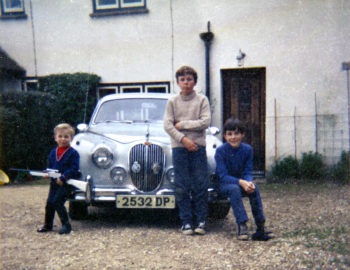
And Padiss Corner where Gamps and his second wife Dorothy moved after Nanny died triggers very fond memories. Horses, donkeys (had we only known the place they held in Dorothy’s heart…another story for later), cats, and dogs (lovely border collies, one of which was Bunje. There was always a Bunje). A wonderful location near Fordingbridge on the edge of the New Forest, and an opportunity for us to ride (there was a stable next door) and get into trouble playing in the barn of the Dibdon’s farm – across the stream and another “neighbor”.
A sense of place helps anchor stories. I’ll continue to keep the places updated to support the stories about the people.

